Black Swans And Wormhole Wizards is the new record by Joe Satriani. It’s a melodic groove fest that blends the stuff fans really like with elements they’ve wanted to hear more of: High octane guitar playing, a looser rhythm section, and group interaction. Joe’s name is on the cover, but he gets an invaluable assist from producer Mike Fraser, bassist Allen Whitman, longtime drummer Jeff Campitelli, and Mike Keneally on keys.
While on hiatus from the supergroup Chickenfoot featuring Sammy Hagar, Michael Anthony, and Chad Smith, Satriani took some time out from the mayhem to return to the quiet refuge of his solo universe. The process for the new record evolved from home demos and ultimately morphed into a piece of work that traverses the middle ground between the soulful and the bombastic.
While past recordings touched on similar themes and textures, this new release is much more compositionally fluid and displays more depth and range as a songwriter. We’re swept away on an intergalactic flight (with comfortable seating and leg room) that guides us from the mesmerizing to the emotional. His masterfully organized tracklist glides seamlessly from epic rock, contemplative solo guitar, to Middle Eastern atmospherics and back again.
As always he brings tuneful melodies, but this time weaves slow-handed, Scofield-esque behind-the-beat phrasing, emotive gospel stylings, and a stellar band that knows how to breathe as well as rock. PG caught up with Joe the week before the album's October 5 release to learn more about how Black Swans And Wormhole Wizards came together, and the gear he’s digging right now.
How’s it going?
I’m having a good day testing chorus pedals.
Find anything good?
I like the newly-made A/DA Flanger, which isn’t really a chorus pedal, but it’s so neat sounding. It kind of covers chorus. I still like the Voodoo Lab Analog Chorus, and for some reason the Boss Super Chorus is also very clean and not noisy. It helps if you’re using distortion. If you’re not using distortion, then TC Electronic’s chorus is pretty good, along with Analog Man and Red Witch pedals. Even the Electro-Harmonix choruses are okay as long as you’re not using any distortion. Once you get gain going in the circuit, some pedals can get kind of noisy, so that always leads me back to the A/DA, the Voodoo Labs, and the Super Chorus.
You have to check out those pedals clean as well as dirty or you’ll get a weird surprise.
Yeah, basically the old bucket brigade style choruses were very noisy. They cut a lot of low end and high end out. They’ve been sort of upgraded, but as they get cleaner sounding, they lose some kind of soul. When you go from analog to digital, you get the headroom, there’s no distortion, you keep your low end, but it’s not wild and crazy like a foot pedal should be. It’s more like a studio effect. That’s kind of like what you’re always balancing with. They’re all pretty good. They all do their job, but when you’re zeroing in on just a few very important attributes, you start to see that there are some units that are better than others.
What’s been going on since you finished the record?
It’s been very busy. As soon as I finished mixing the record in Vancouver, I was back home doing Chickenfoot demos. I handed ten songs off to Sammy, then we did two shows about a week ago. That’ll be it for the rest of the year for Chickenfoot as far as shows go. Then we’re hoping to be in the studio at the end of January when my solo tour takes a break. I’m very excited about it. I think it’s going to be a great record. I can’t wait to see what Sammy decides to sing about.
Tell me about how the process began with Black Swans And Wormhole Wizards?
It started with John Cuniberti, my longtime co-producer and good friend. He came over and helped me redesign my studio. We turned my studio around 180 degrees and put up a lot of sound dampening stuff. He did a real professional job with it to get the room to be as dead as possible. I repositioned my desk, I upgraded all my Pro Tools, got a new screen, started using my Meyer HD-1, and I got rid of all my old keyboards and my V-Drum set, which is what I used to build my demos. I started doing everything with Native Instruments and BFD. It really helped my demo process.
Coming back from the Experience Hendrix tour in March, I was able to crank out lots of demos really fast. It didn’t slow down my writing process, which was what my old system was doing. The upgrade really helped. The room sounded great. I could work in it for eight or ten hours and my ears would never get tired. I wound up writing a lot of songs and had two months to get all the demos together for the guys. I wound up doing about sixty percent of the guitars or more at home, and some of the keyboard work as well.
Do you carry a little recorder around with you to catch ideas as they come to you, or do you wait until you get to your studio to make stuff up from scratch?
We’re all surrounded with digital devices now. The demo that we used for the arrangement of “Little Worth Lane” was actually recorded on my iPhone on a backstage piano on the Hendrix tour. That became the blueprint of that song. I’ve got a lot of the Zoom products like the Q3 and H4 for video as well as audio—amazing sounding audio recording device. I use that a lot.
When you have a studio in your house, it’s easy. It takes about two minutes to fire everything up and I’m recording. I record most of the guitars direct and sometimes even go through an amp. That allows me to get unusual performances recorded, and then go into a real studio and re-amp them into as many amps as I want. I can turn them up, get creative with speakers, and things like that.
I ask because the new record, while very melodic, doesn’t sound overly produced like a lot of guitar instrumental records. It breathes and grooves. Does that come from melodies made up in your head or improvising over grooves?
There are a lot of people who should take credit for how the whole thing turned out eventually. The thing about the groove is very important. I always keep a very keen eye on the fact that I’m a rock ‘n’ roll artist and I want to make rock ‘n’ roll records. I don’t want things to sound hastily thrown together, but I don’t want them to sound overly produced. I want it to be fun to listen to. I want people to be able to listen to it over and over again for decades.
For me, that means that there has to be some kind of looseness and playfulness even if you’re doing a song about a dire situation or something sad. There has to be life in everybody’s performance, which means when you get into the studio with the band, you have to let everybody feel that they can contribute. You gotta listen to what they’re telling you about their parts. As a writer you have it in your mind what you think the song could do—how it could achieve its goal. When you make demos of course, it’s really sort of a pale version of what’s in your mind and in your heart about the song. So I always tell the guys, “Hey, this is just a demo. Some of the parts we’ll use but feel free to explore your parts.”
 I love working with co-producers, because if I’m out there in the music room with my guitar on, I want to be like a crazy guitar player. I’d rather be told to stop going off the wild deep-end and rein it in, rather than somebody saying, “Hey, we need some kind of performance from you.” [Laughing] It’s great to get out of the control room as the co-producer and just put on a guitar, and have somebody like Mike Fraser come out and say, “Joe you can keep going in that direction. Mike [Keneally, keyboard], why don’t we try this, Jeff [Campitelli, drums], let’s change the snare. I love what you’re doing with that beat, can you do that at this other section of the song?” Then talking to Allen [Whitman, bass] about all the cool things he’s doing.
I love working with co-producers, because if I’m out there in the music room with my guitar on, I want to be like a crazy guitar player. I’d rather be told to stop going off the wild deep-end and rein it in, rather than somebody saying, “Hey, we need some kind of performance from you.” [Laughing] It’s great to get out of the control room as the co-producer and just put on a guitar, and have somebody like Mike Fraser come out and say, “Joe you can keep going in that direction. Mike [Keneally, keyboard], why don’t we try this, Jeff [Campitelli, drums], let’s change the snare. I love what you’re doing with that beat, can you do that at this other section of the song?” Then talking to Allen [Whitman, bass] about all the cool things he’s doing.
It really helps the atmosphere so everybody feels creative. A take is just a take. We’ll do a lot of them so you might as well explore. Sooner or later we’re all smiling at each other because we realize it’s really coming together. It’s way better than what the demo had suggested. We’re off in a new area.
Give me an example of that.
“God Is Crying” had a really different beginning in the demo. It was just bass and guitar. I was just hammering out the riff. I never really liked it, but I was kind of waiting for something to happen in the studio. When these guys got together, the chemistry was really good. Every time we would get ready for a song, there’d be all this crazy jamming. We’d have to be told to stop and concentrate on the song at hand.
I really like that you let Mike Keneally loose on the piano solo to “Wind In The Trees.” It adds so much to the flowing quality of the record.
He is a genius. When I started making the demos for the record, I was keen on having keyboards as one of my themes. I’m a chordal player. I don’t really solo or anything, so I started to build into the songs these sections where I wanted somebody to answer me. I wanted somebody to be my foil against the melody. At times I was thinking I wanted to hear a piano stretched out somehow. So I started thinking, “Who do I know who is a great piano player, but understands what a guitar player likes to do?” It came to my mind that Mike Keneally is probably one of the few who can actually understand that concept, and probably the only guy who can really blow on both instruments. He’s just amazing.
I was lucky enough to give him a call and find out that he was available for the sessions. I basically left these big holes for him and said, “You just do whatever you want.” Other places I said, “Electric piano.” I’d have him replace parts that I had done where I already had their texture kind of in the ballpark. He became the fourth member, which was extremely important. He didn’t just come and overdub. He was there cutting the basics. He was able to expand upon my ideas beyond where I thought they could go.
It sounds like a real band in the same room playing off each other.
You hit the nail right on the head. He was listening to my weird Auto-Tuned melody guitar, then he’s listening to my Sustainiac pickup solo guitar, and I said, “When it’s your turn, you just go off.” I gave him a lot of measures to just kind of go off and finish the song. Every take he played a brilliant solo. It was so hard to pick one.
Did you use Auto-Tune on the solos to “Light Years Away” and “Pyrrhic Victoria?”
No. Those are two different sounds. On “Light Years Away” it’s just a straight-ahead guitar.
It sounds like there’s a subtle octavia sound going on.
You might just be hearing upper harmonics. Mike Fraser is an amazing mixer and he makes everything sound very rich. That’s actually the guitar tone I got here at my home studio. On “Pyrrhic Victoria,” that’s one of the solos that we cut live with the band. On that one I think I was using a Fulltone Deja Vibe or something like that. That basically gives a frequency shift. It makes the guitar sound a bit like an organ or like an old Hendrix tone.
With the Auto-Tune thing, we used it as an effect only on that one song, “Wind In The Trees” as a melody. What it does is, it doesn’t allow the guitar to stray. Not only out of tune, but out of key. I’ve used it before on a techno album called Engines Of Creation, but it really just made the guitar sound like a keyboard so it wasn’t very interesting.
I realized that I had been using it in the wrong way. I hadn’t been using it like a guitar player does with chorus pedals or wah-wah pedals, where you plug into it and then you react to what you hear. I thought, I’ll set up something where I’m going to only be listening to what it sounds like coming out of the Auto-Tune. I realized if I played like a drunken idiot, that the program would work so hard to get me in tune, that it would create this other sound—which was this sort of vocal quality. The software was working hard to pull me back into the key. It started to sound really interesting. So if I did a wild vibrato bar bend going Wwrrrrrrrrrr, it would go Wrrddddddd, and make sure every stop along the way was in the key that I had programmed it. I thought it was the funniest thing ever. It was like guitar player’s revenge. [Laughing]

Did you use the Saturator or the Ice Nine pedals at all?
I believe the Saturator was used for the solo in “Light Years Away.” That would have been through an old [Marshall] 6100 amp and then probably through my old Millennia FTP 1 which functions just like a light compressor and a DI, and went straight into Pro Tools. That was done at home. I don’t think I used the Saturator on anything else. Everything else was just basically the Marshall JVM amp for 90 percent of the work, and some Wizard amps for a couple of songs. I have a specially-made custom reverb by Two-Rock they made for me early in the year that sounds really nice.
Was there any residual Chickenfootness that you brought to the record?
[Laughing] I spent quite a lot of time recording, going on tour, and doing the live DVD with Chickenfoot. During the writing sessions I started to get the sense that I was really enjoying the process of being with a band, seeing where the band can really morph your ideas rhythmically, and how something can play out. In the studio I put it to Mike Fraser that I really wanted the album to have a band sound. I wanted everybody to feel like they had room to inject some of their own ideas into the songs, and I wanted the guitar to have this emotional impact that we had never yet achieved.
Mike and I have been doing records together since ’96 – ’97, so we’d done a lot of work together. He mixed the Chickenfoot album as well, so I think he understood what I was going for. Since he had mixed the Chickenfoot Get Your Buzz On live DVD, he had a good handle on what I meant by trying to capture a live feel. So I think that was the Chickenfootedness that spilled over.
Have you stopped using the Peavey JSX amps completely?
I haven’t used the JSX amps since the Chickenfoot tour started over a year ago. We did that first club tour through the U.S. back in May of last year. When I got back, I met Sammy at his studio. We both plugged into some Marshalls that we had and we thought, “We gotta go back to playing Marshalls!” We knew what Chickenfoot really needed. He was playing is own Crate model before that. Just like that, the two of us switched to Marshall. The next week we flew to Vienna and Marshall had a bunch of amps waiting for us. Then I started trying to figure out how to use the JVMs, and I’ve had a lot of fun with those amps. They’ve been really amazing sounding on the Chickenfoot tour, and they wound up having a great presence on my new solo record.
They’re so articulate, which is so unusual when you’re looking for an amp that can handle lots of levels of gain. The engineer Santiago Alvarez at Marshall figured out a way to get them to be big and ballsy. They have a way of being very articulate, which really helps me out when I’m trying to concentrate on phrasing. I want people to hear every little nuance of my picking.
I saw you on the Chickenfoot tour right after the switch. Your sound was a lot more rugged.
It was much bigger. There’s no substitute for turning up loud and using an all tube amplifier. The EQ was passive, whereas the JSX had an active EQ. Part of the problem I had with Peavey is that after the amp initially came out, the changes that I wanted to see made to the amp were way too slow in coming. During the production of the Chickenfoot album we were working on a 50-watt head, and there was just no progress. It was grinding to a halt and I was wondering, “What is going on with you guys? How come there isn’t an engineer working on this stuff for me?”
If an artist is going to endorse a product, they have to get support from the company. If they don’t, then they give up too much by always having to play this thing that their name and face are attached to. Peavey makes a lot of great things, but at the time it seemed like the engineer they had was not really responding to me or the other artists enough. I either needed to not be endorsed by somebody, or go to a company where they really did want to help me out quickly, and make changes as changes were needed.
Any surprises for the upcoming tour?
I think the whole tour is going to be a surprise. As I look at the set list, we’re playing a lot of the new album, and we’re pulling out a lot of songs that either I’ve never played live before, or haven’t been in the set list for years. For those people who’ve seen us live, they’re gonna see a lot of surprises.
Joe’s Gear Box
Guitars
Ibanez JS2400
Ibanez JS1200
Ibanez JS Single Coil Prototype
Amp
Marshall JVM410 (Modified)
Effects
Vox Saturator
Vox Big Bad Wah
Vox Time Machine
Vox Ice 9
While on hiatus from the supergroup Chickenfoot featuring Sammy Hagar, Michael Anthony, and Chad Smith, Satriani took some time out from the mayhem to return to the quiet refuge of his solo universe. The process for the new record evolved from home demos and ultimately morphed into a piece of work that traverses the middle ground between the soulful and the bombastic.
While past recordings touched on similar themes and textures, this new release is much more compositionally fluid and displays more depth and range as a songwriter. We’re swept away on an intergalactic flight (with comfortable seating and leg room) that guides us from the mesmerizing to the emotional. His masterfully organized tracklist glides seamlessly from epic rock, contemplative solo guitar, to Middle Eastern atmospherics and back again.
As always he brings tuneful melodies, but this time weaves slow-handed, Scofield-esque behind-the-beat phrasing, emotive gospel stylings, and a stellar band that knows how to breathe as well as rock. PG caught up with Joe the week before the album's October 5 release to learn more about how Black Swans And Wormhole Wizards came together, and the gear he’s digging right now.
How’s it going?
I’m having a good day testing chorus pedals.
Find anything good?
I like the newly-made A/DA Flanger, which isn’t really a chorus pedal, but it’s so neat sounding. It kind of covers chorus. I still like the Voodoo Lab Analog Chorus, and for some reason the Boss Super Chorus is also very clean and not noisy. It helps if you’re using distortion. If you’re not using distortion, then TC Electronic’s chorus is pretty good, along with Analog Man and Red Witch pedals. Even the Electro-Harmonix choruses are okay as long as you’re not using any distortion. Once you get gain going in the circuit, some pedals can get kind of noisy, so that always leads me back to the A/DA, the Voodoo Labs, and the Super Chorus.
You have to check out those pedals clean as well as dirty or you’ll get a weird surprise.
Yeah, basically the old bucket brigade style choruses were very noisy. They cut a lot of low end and high end out. They’ve been sort of upgraded, but as they get cleaner sounding, they lose some kind of soul. When you go from analog to digital, you get the headroom, there’s no distortion, you keep your low end, but it’s not wild and crazy like a foot pedal should be. It’s more like a studio effect. That’s kind of like what you’re always balancing with. They’re all pretty good. They all do their job, but when you’re zeroing in on just a few very important attributes, you start to see that there are some units that are better than others.
What’s been going on since you finished the record?
It’s been very busy. As soon as I finished mixing the record in Vancouver, I was back home doing Chickenfoot demos. I handed ten songs off to Sammy, then we did two shows about a week ago. That’ll be it for the rest of the year for Chickenfoot as far as shows go. Then we’re hoping to be in the studio at the end of January when my solo tour takes a break. I’m very excited about it. I think it’s going to be a great record. I can’t wait to see what Sammy decides to sing about.
Tell me about how the process began with Black Swans And Wormhole Wizards?
It started with John Cuniberti, my longtime co-producer and good friend. He came over and helped me redesign my studio. We turned my studio around 180 degrees and put up a lot of sound dampening stuff. He did a real professional job with it to get the room to be as dead as possible. I repositioned my desk, I upgraded all my Pro Tools, got a new screen, started using my Meyer HD-1, and I got rid of all my old keyboards and my V-Drum set, which is what I used to build my demos. I started doing everything with Native Instruments and BFD. It really helped my demo process.
Coming back from the Experience Hendrix tour in March, I was able to crank out lots of demos really fast. It didn’t slow down my writing process, which was what my old system was doing. The upgrade really helped. The room sounded great. I could work in it for eight or ten hours and my ears would never get tired. I wound up writing a lot of songs and had two months to get all the demos together for the guys. I wound up doing about sixty percent of the guitars or more at home, and some of the keyboard work as well.
Do you carry a little recorder around with you to catch ideas as they come to you, or do you wait until you get to your studio to make stuff up from scratch?
We’re all surrounded with digital devices now. The demo that we used for the arrangement of “Little Worth Lane” was actually recorded on my iPhone on a backstage piano on the Hendrix tour. That became the blueprint of that song. I’ve got a lot of the Zoom products like the Q3 and H4 for video as well as audio—amazing sounding audio recording device. I use that a lot.
When you have a studio in your house, it’s easy. It takes about two minutes to fire everything up and I’m recording. I record most of the guitars direct and sometimes even go through an amp. That allows me to get unusual performances recorded, and then go into a real studio and re-amp them into as many amps as I want. I can turn them up, get creative with speakers, and things like that.
I ask because the new record, while very melodic, doesn’t sound overly produced like a lot of guitar instrumental records. It breathes and grooves. Does that come from melodies made up in your head or improvising over grooves?
There are a lot of people who should take credit for how the whole thing turned out eventually. The thing about the groove is very important. I always keep a very keen eye on the fact that I’m a rock ‘n’ roll artist and I want to make rock ‘n’ roll records. I don’t want things to sound hastily thrown together, but I don’t want them to sound overly produced. I want it to be fun to listen to. I want people to be able to listen to it over and over again for decades.
For me, that means that there has to be some kind of looseness and playfulness even if you’re doing a song about a dire situation or something sad. There has to be life in everybody’s performance, which means when you get into the studio with the band, you have to let everybody feel that they can contribute. You gotta listen to what they’re telling you about their parts. As a writer you have it in your mind what you think the song could do—how it could achieve its goal. When you make demos of course, it’s really sort of a pale version of what’s in your mind and in your heart about the song. So I always tell the guys, “Hey, this is just a demo. Some of the parts we’ll use but feel free to explore your parts.”
 I love working with co-producers, because if I’m out there in the music room with my guitar on, I want to be like a crazy guitar player. I’d rather be told to stop going off the wild deep-end and rein it in, rather than somebody saying, “Hey, we need some kind of performance from you.” [Laughing] It’s great to get out of the control room as the co-producer and just put on a guitar, and have somebody like Mike Fraser come out and say, “Joe you can keep going in that direction. Mike [Keneally, keyboard], why don’t we try this, Jeff [Campitelli, drums], let’s change the snare. I love what you’re doing with that beat, can you do that at this other section of the song?” Then talking to Allen [Whitman, bass] about all the cool things he’s doing.
I love working with co-producers, because if I’m out there in the music room with my guitar on, I want to be like a crazy guitar player. I’d rather be told to stop going off the wild deep-end and rein it in, rather than somebody saying, “Hey, we need some kind of performance from you.” [Laughing] It’s great to get out of the control room as the co-producer and just put on a guitar, and have somebody like Mike Fraser come out and say, “Joe you can keep going in that direction. Mike [Keneally, keyboard], why don’t we try this, Jeff [Campitelli, drums], let’s change the snare. I love what you’re doing with that beat, can you do that at this other section of the song?” Then talking to Allen [Whitman, bass] about all the cool things he’s doing.
It really helps the atmosphere so everybody feels creative. A take is just a take. We’ll do a lot of them so you might as well explore. Sooner or later we’re all smiling at each other because we realize it’s really coming together. It’s way better than what the demo had suggested. We’re off in a new area.
Give me an example of that.
“God Is Crying” had a really different beginning in the demo. It was just bass and guitar. I was just hammering out the riff. I never really liked it, but I was kind of waiting for something to happen in the studio. When these guys got together, the chemistry was really good. Every time we would get ready for a song, there’d be all this crazy jamming. We’d have to be told to stop and concentrate on the song at hand.
I really like that you let Mike Keneally loose on the piano solo to “Wind In The Trees.” It adds so much to the flowing quality of the record.
He is a genius. When I started making the demos for the record, I was keen on having keyboards as one of my themes. I’m a chordal player. I don’t really solo or anything, so I started to build into the songs these sections where I wanted somebody to answer me. I wanted somebody to be my foil against the melody. At times I was thinking I wanted to hear a piano stretched out somehow. So I started thinking, “Who do I know who is a great piano player, but understands what a guitar player likes to do?” It came to my mind that Mike Keneally is probably one of the few who can actually understand that concept, and probably the only guy who can really blow on both instruments. He’s just amazing.
I was lucky enough to give him a call and find out that he was available for the sessions. I basically left these big holes for him and said, “You just do whatever you want.” Other places I said, “Electric piano.” I’d have him replace parts that I had done where I already had their texture kind of in the ballpark. He became the fourth member, which was extremely important. He didn’t just come and overdub. He was there cutting the basics. He was able to expand upon my ideas beyond where I thought they could go.
It sounds like a real band in the same room playing off each other.
You hit the nail right on the head. He was listening to my weird Auto-Tuned melody guitar, then he’s listening to my Sustainiac pickup solo guitar, and I said, “When it’s your turn, you just go off.” I gave him a lot of measures to just kind of go off and finish the song. Every take he played a brilliant solo. It was so hard to pick one.
Did you use Auto-Tune on the solos to “Light Years Away” and “Pyrrhic Victoria?”
No. Those are two different sounds. On “Light Years Away” it’s just a straight-ahead guitar.
It sounds like there’s a subtle octavia sound going on.
You might just be hearing upper harmonics. Mike Fraser is an amazing mixer and he makes everything sound very rich. That’s actually the guitar tone I got here at my home studio. On “Pyrrhic Victoria,” that’s one of the solos that we cut live with the band. On that one I think I was using a Fulltone Deja Vibe or something like that. That basically gives a frequency shift. It makes the guitar sound a bit like an organ or like an old Hendrix tone.
With the Auto-Tune thing, we used it as an effect only on that one song, “Wind In The Trees” as a melody. What it does is, it doesn’t allow the guitar to stray. Not only out of tune, but out of key. I’ve used it before on a techno album called Engines Of Creation, but it really just made the guitar sound like a keyboard so it wasn’t very interesting.
I realized that I had been using it in the wrong way. I hadn’t been using it like a guitar player does with chorus pedals or wah-wah pedals, where you plug into it and then you react to what you hear. I thought, I’ll set up something where I’m going to only be listening to what it sounds like coming out of the Auto-Tune. I realized if I played like a drunken idiot, that the program would work so hard to get me in tune, that it would create this other sound—which was this sort of vocal quality. The software was working hard to pull me back into the key. It started to sound really interesting. So if I did a wild vibrato bar bend going Wwrrrrrrrrrr, it would go Wrrddddddd, and make sure every stop along the way was in the key that I had programmed it. I thought it was the funniest thing ever. It was like guitar player’s revenge. [Laughing]
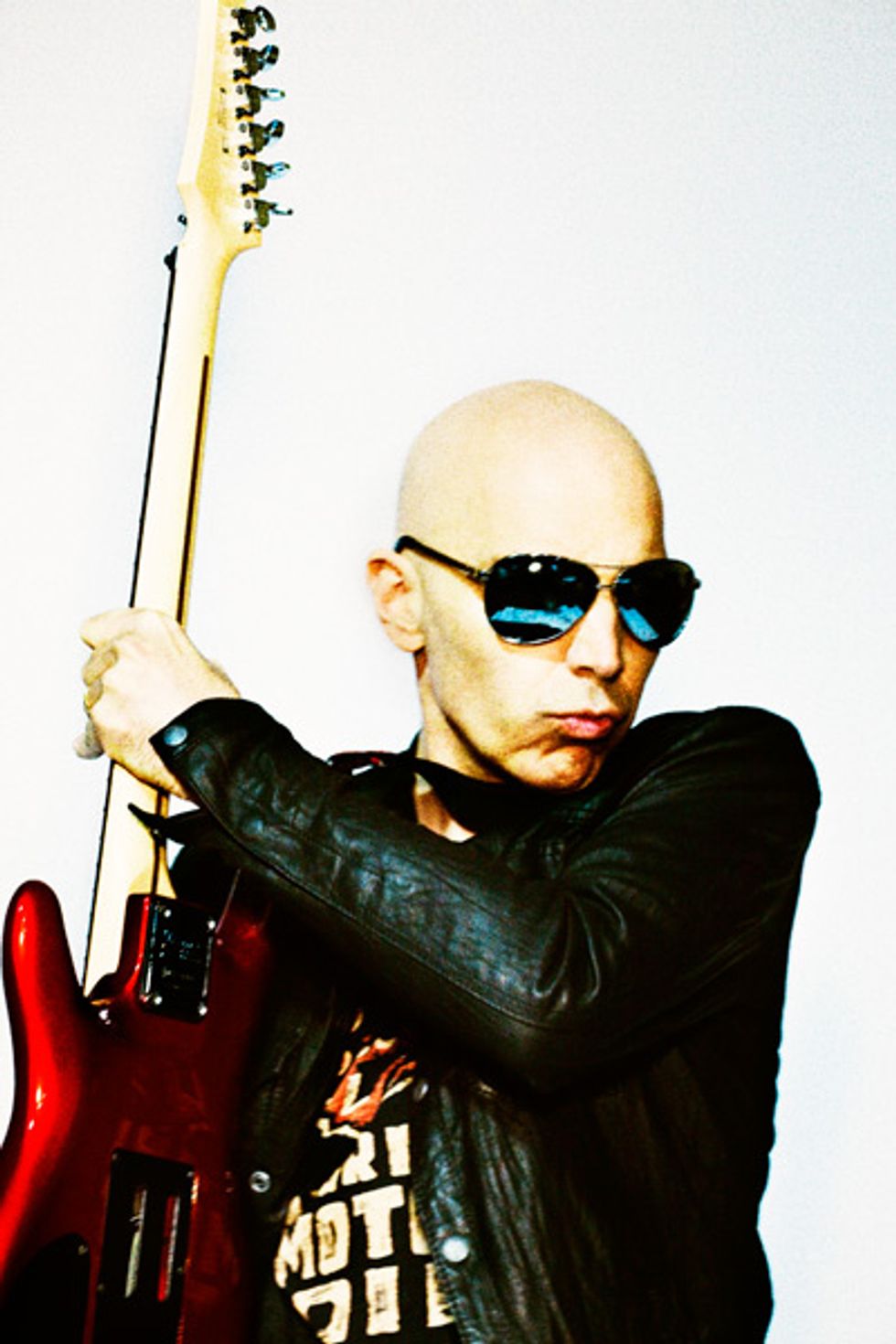
Did you use the Saturator or the Ice Nine pedals at all?
I believe the Saturator was used for the solo in “Light Years Away.” That would have been through an old [Marshall] 6100 amp and then probably through my old Millennia FTP 1 which functions just like a light compressor and a DI, and went straight into Pro Tools. That was done at home. I don’t think I used the Saturator on anything else. Everything else was just basically the Marshall JVM amp for 90 percent of the work, and some Wizard amps for a couple of songs. I have a specially-made custom reverb by Two-Rock they made for me early in the year that sounds really nice.
Was there any residual Chickenfootness that you brought to the record?
[Laughing] I spent quite a lot of time recording, going on tour, and doing the live DVD with Chickenfoot. During the writing sessions I started to get the sense that I was really enjoying the process of being with a band, seeing where the band can really morph your ideas rhythmically, and how something can play out. In the studio I put it to Mike Fraser that I really wanted the album to have a band sound. I wanted everybody to feel like they had room to inject some of their own ideas into the songs, and I wanted the guitar to have this emotional impact that we had never yet achieved.
Mike and I have been doing records together since ’96 – ’97, so we’d done a lot of work together. He mixed the Chickenfoot album as well, so I think he understood what I was going for. Since he had mixed the Chickenfoot Get Your Buzz On live DVD, he had a good handle on what I meant by trying to capture a live feel. So I think that was the Chickenfootedness that spilled over.
Have you stopped using the Peavey JSX amps completely?
I haven’t used the JSX amps since the Chickenfoot tour started over a year ago. We did that first club tour through the U.S. back in May of last year. When I got back, I met Sammy at his studio. We both plugged into some Marshalls that we had and we thought, “We gotta go back to playing Marshalls!” We knew what Chickenfoot really needed. He was playing is own Crate model before that. Just like that, the two of us switched to Marshall. The next week we flew to Vienna and Marshall had a bunch of amps waiting for us. Then I started trying to figure out how to use the JVMs, and I’ve had a lot of fun with those amps. They’ve been really amazing sounding on the Chickenfoot tour, and they wound up having a great presence on my new solo record.
They’re so articulate, which is so unusual when you’re looking for an amp that can handle lots of levels of gain. The engineer Santiago Alvarez at Marshall figured out a way to get them to be big and ballsy. They have a way of being very articulate, which really helps me out when I’m trying to concentrate on phrasing. I want people to hear every little nuance of my picking.
I saw you on the Chickenfoot tour right after the switch. Your sound was a lot more rugged.
It was much bigger. There’s no substitute for turning up loud and using an all tube amplifier. The EQ was passive, whereas the JSX had an active EQ. Part of the problem I had with Peavey is that after the amp initially came out, the changes that I wanted to see made to the amp were way too slow in coming. During the production of the Chickenfoot album we were working on a 50-watt head, and there was just no progress. It was grinding to a halt and I was wondering, “What is going on with you guys? How come there isn’t an engineer working on this stuff for me?”
If an artist is going to endorse a product, they have to get support from the company. If they don’t, then they give up too much by always having to play this thing that their name and face are attached to. Peavey makes a lot of great things, but at the time it seemed like the engineer they had was not really responding to me or the other artists enough. I either needed to not be endorsed by somebody, or go to a company where they really did want to help me out quickly, and make changes as changes were needed.
Any surprises for the upcoming tour?
I think the whole tour is going to be a surprise. As I look at the set list, we’re playing a lot of the new album, and we’re pulling out a lot of songs that either I’ve never played live before, or haven’t been in the set list for years. For those people who’ve seen us live, they’re gonna see a lot of surprises.
Joe’s Gear Box
Guitars
Ibanez JS2400
Ibanez JS1200
Ibanez JS Single Coil Prototype
Amp
Marshall JVM410 (Modified)
Effects
Vox Saturator
Vox Big Bad Wah
Vox Time Machine
Vox Ice 9


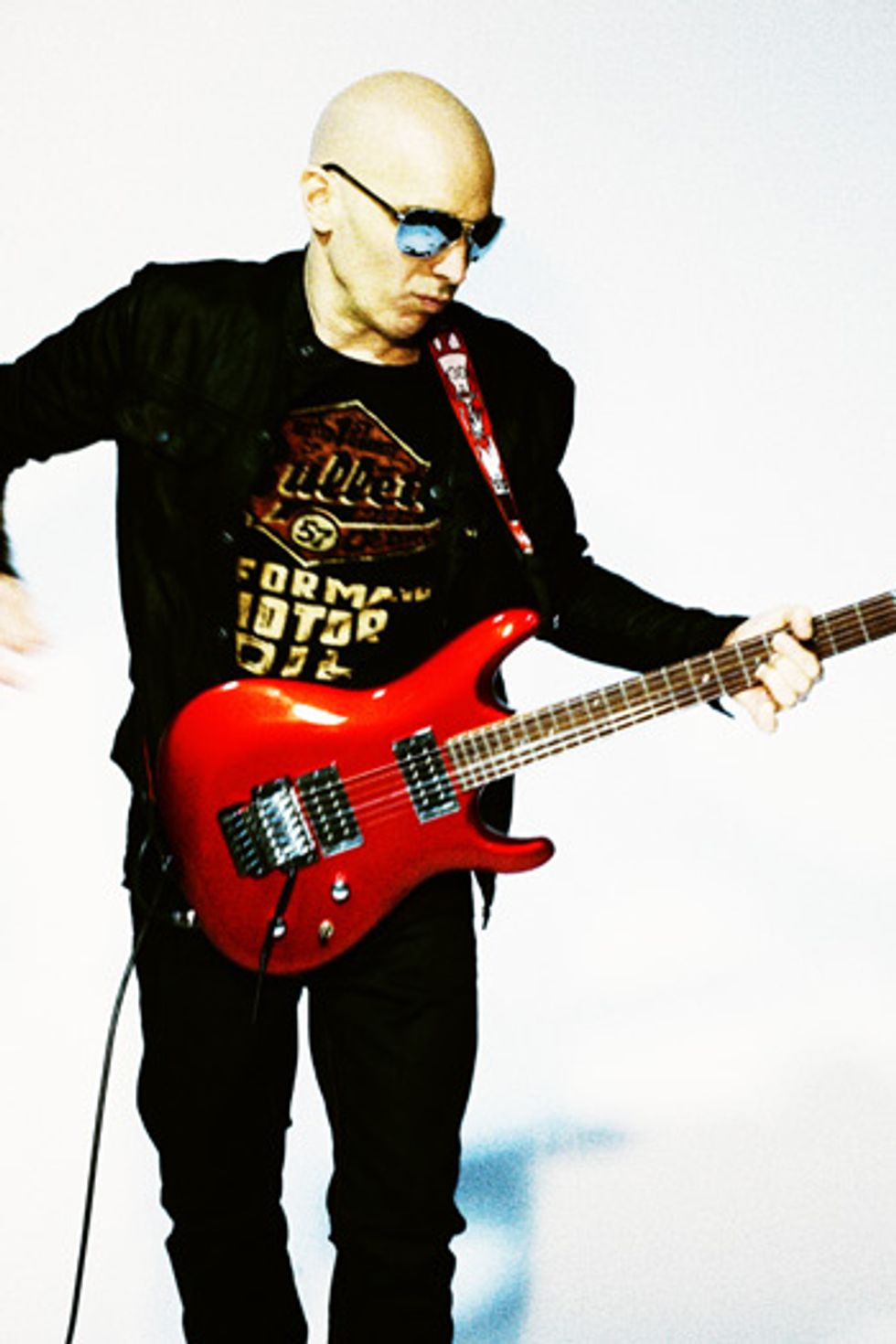

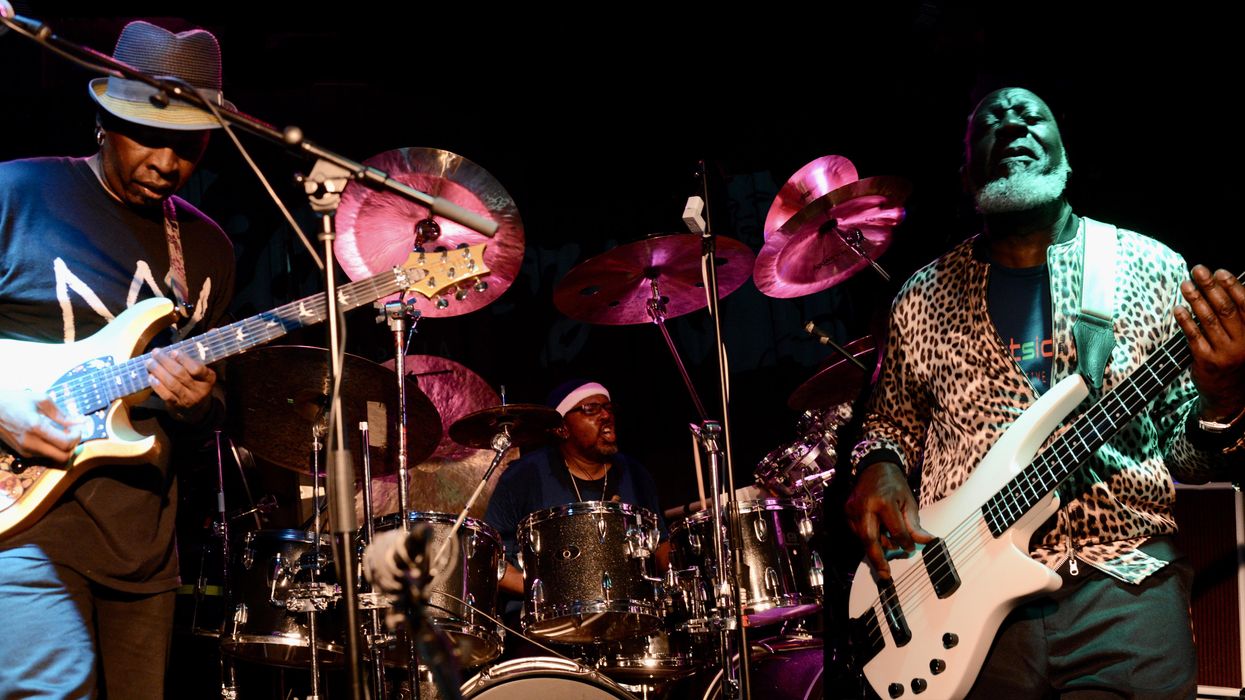
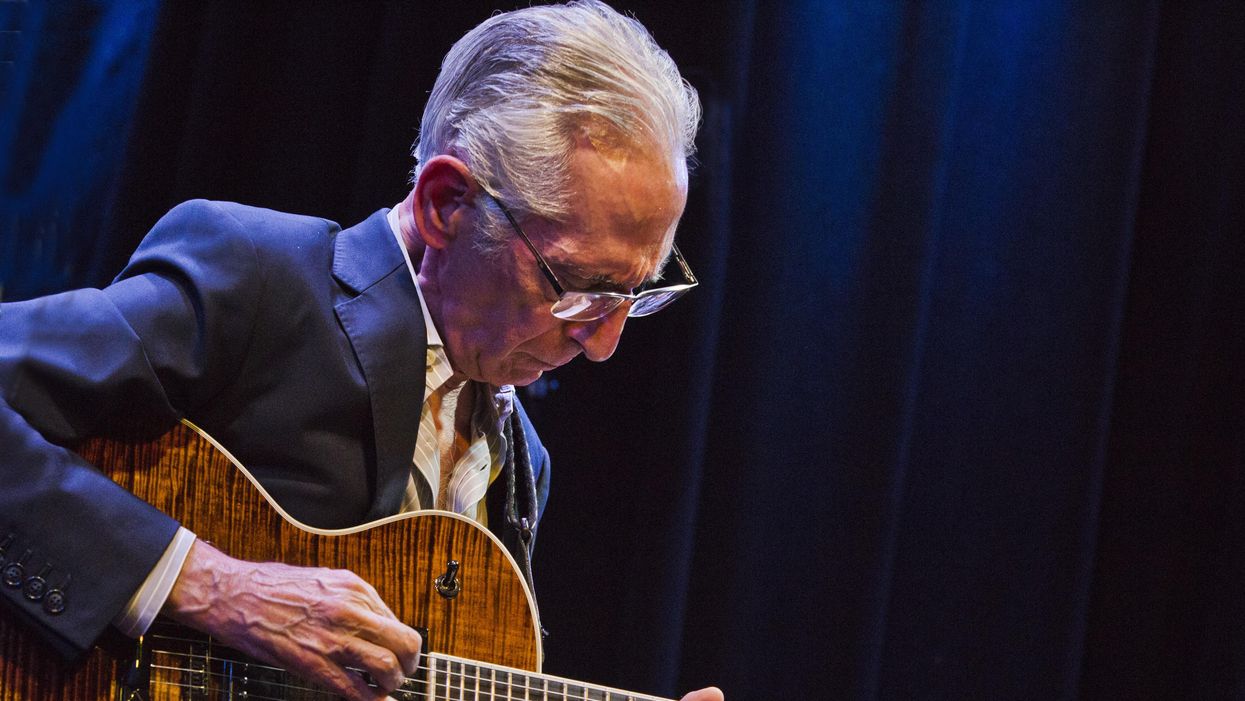



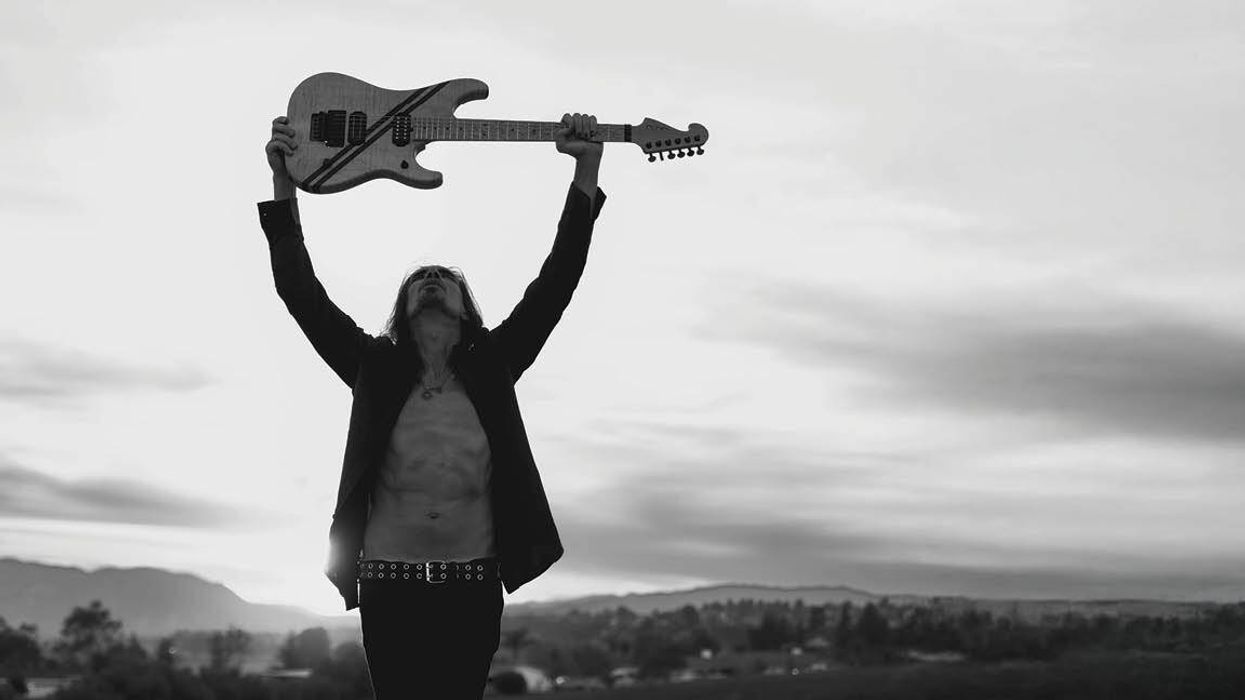
![Rig Rundown: Russian Circles’ Mike Sullivan [2025]](https://www.premierguitar.com/media-library/youtube.jpg?id=62303631&width=1245&height=700&quality=70&coordinates=0%2C0%2C0%2C0)

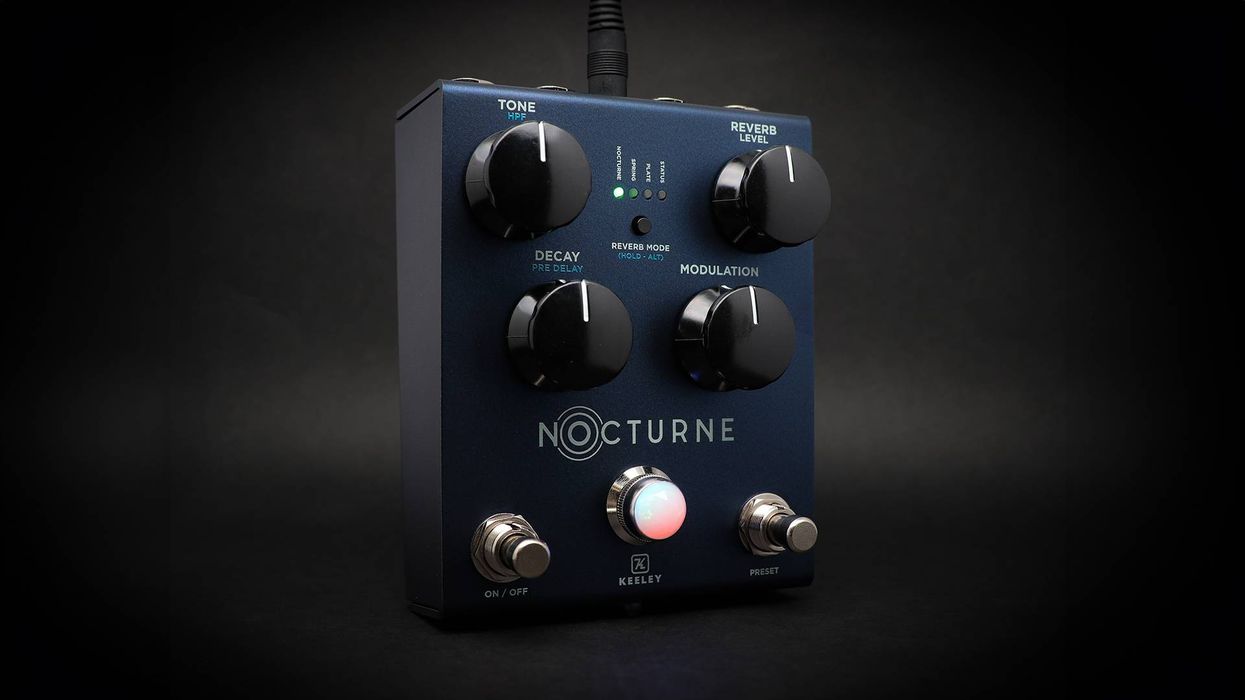
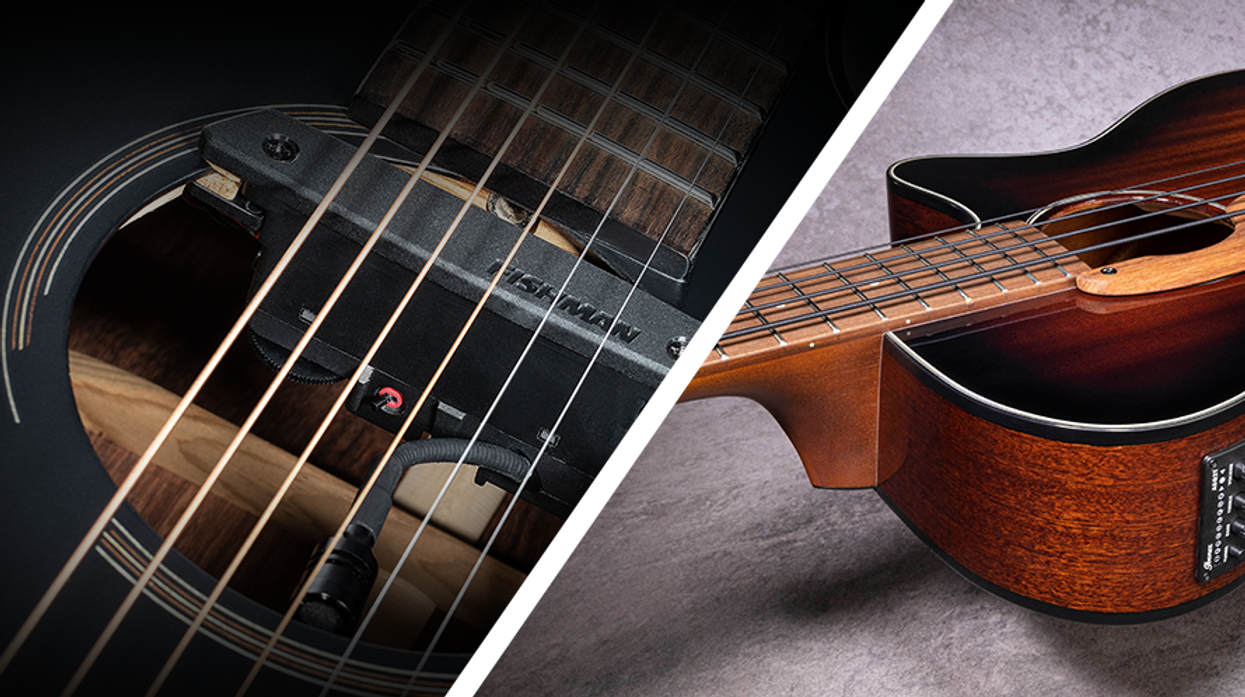










![Rig Rundown: AFI [2025]](https://www.premierguitar.com/media-library/youtube.jpg?id=62064741&width=1245&height=700&quality=70&coordinates=0%2C0%2C0%2C0)




















 Zach loves his Sovtek Mig 60 head, which he plays through a cab he built himself at a pipe-organ shop in Denver. Every glue joint is lined with thin leather for maximum air tightness, and it’s stocked with Celestion G12M Greenback speakers.
Zach loves his Sovtek Mig 60 head, which he plays through a cab he built himself at a pipe-organ shop in Denver. Every glue joint is lined with thin leather for maximum air tightness, and it’s stocked with Celestion G12M Greenback speakers.











